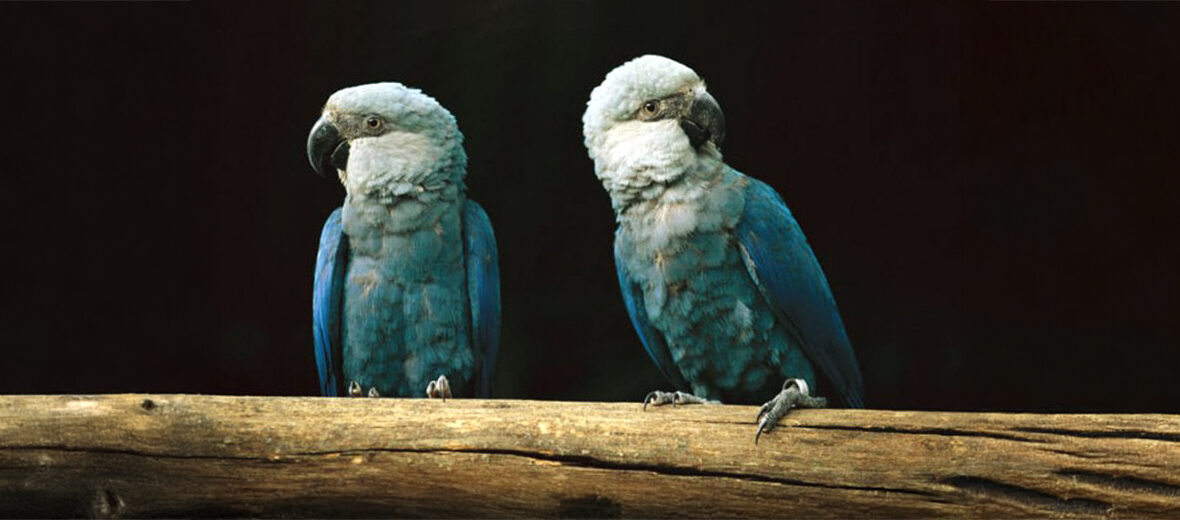
The Spix’s macaw, aka little blue macaw, is a beautiful parrot species that was originally found only in Brazil. Due to the threats of habitat loss and destruction at the hands of farming, ranching, renewable energy, and logging (both legal and illegal); hunting; trapping; and invasive species, that lead to disease and predation, these parrots are now considered to be extinct. They only exist, in limited numbers, in captivity. The IUCN lists these birds as Extinct in the Wild. However, this is changing! Read more…
First the Stats…
Scientific name: Cyanopsitta spixii
Weight: Up to 11 ounces
Length: Up to 23.5 inches
Wingspan: Up to 11.8 inches
Lifespan: Up to 40 years
Now on to the Facts!
1.) There are only an estimated 360 captive specimens remaining, as of 2024.
2.) These parrots were first described by German naturalist Georg Marcgrave, while he was working in the State of Pernambuco, Brazil in 1638 and they are named after German naturalist Johann Baptist von Spix, who collected a specimen in 1819.
3.) This species of parrot are not sexually dimorphic as males and females look almost identical. However, the females are slightly smaller.
4.) They prefer riparian Caraibeira (Tabebuia aurea) woodland mezzanines in the drainage basin of the Rio São Francisco which is within the Caatinga dry forest climate of interior northeastern Brazil.
5.) The reason for their very specific habitat preference is due to their dependence on the Caraibeira trees for nesting.
But wait, there’s more on the Spix’s macaw!
6.) They mostly feed on the seeds and nuts of Caraiba and various Euphorbiaceae (spurge) shrub vegetation. Seeds from Pinhão and Favela, & nuts from Angico, Baraúna, Facheiro species, Imburana, Joazeiro, Umbu, and Unha-de-gato are also eaten.
7.) These parrots are presently managed and cared for through captive breeding programs at numerous conservation organizations under the aegis of the Brazilian government.
Did you know…?
After over 20 years of intense conservation efforts, 200 macaws have been bred from just 2 parent birds, and 52 individuals have since been reintroduced into their natural environment as of June 2022.
8.) The Brazilian Chico Mendes Institute for Biodiversity Conservation (ICMBio) is currently conducting a project called Ararinha-Azul (translated to Spix’s Macaw) with a concurrent plan to restore these parrots back to the wild as soon as a sufficient amount of breeding birds and restored habitat are available.
9.) The genus name hails from the Ancient Greek word kuanos which translates to “blue” and psittakos which translates to “parrot”.
10.) In captivity, sexual maturity is reached rather late in life (at up to 7 years). This is likely due to inbreeding challenges and other environmental factors. It is presumed that sexual maturity is reached at a much earlier age in the wild.
But wait, there’s still more on the Spix’s macaw!
11.) Nests are constructed in the hollows of large mature Caraibeira trees. They are also used each year afterwards.
12.) Females lay up to 7 eggs, with 3 being the average. The eggs are incubated for up to 28 days.
Did you know…?
Due to 100 years of intensive burning, logging, and grazing of the Caatinga, accompanied by centuries of deforestation, human encroachment, and agricultural development, these already rare parrots had little chance of survival in the wild.
13.) Only the female performs incubation duties.
14.) Chicks fledge in up to 70 days and are independent in up to 130 days.
15.) Their calls are a “whichaka” sound as well as squawking and a repeated short grating sound.
But wait, there’s still a little more on the Spix’s macaw!
16.) The existing captive population is descended from a mere 7 wild caught founder birds, which are thought to have all hailed from just 2 wild nests that existed after 1982.
17.) Captive populations suffer from very low heterozygosity (the state of having 2 different versions of a gene, or alleles, for a particular trait). The original wild caught founder birds were few, closely related in the wild, and intensively inbred in captivity. This resulted in infertility, and a high rate of embryo deaths (at AWWP, only 1 in 6 eggs laid are fertile; only 2/3 of those hatch).
18.) In 2018, the population of these birds numbered approximately 158, and an agreement was then signed between the Ministry of the Environment of Brazil and conservation organizations of Belgium (Pairi Daiza Foundation) and Germany (Association for the Conservation of Threatened Parrots) to set up the repatriation (return to their place of origin) of 50 Spix’s macaws to Brazil by the first quarter of 2019. The Spix’s macaw was eventually reintroduced to the wild in June and December 2022.
19.) From April – July 2021, 3 Spix’s macaw were born in the Caatinga region in the state of Bahia in Brazil, 20 years after the declaration of extinction in the wild by the Brazilian government. The chicks hail from a pair that came from Germany in 2020.
Now a Short Spix’s Macaw Video!
Be sure to share & comment below! Also, check out the Critter Science YouTube channel. Videos added regularly!
Want to suggest a critter for me to write about? Let me know here.
Some source material acquired from: Wikipedia & IUCN
Photo credit: Etna




